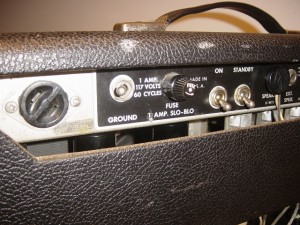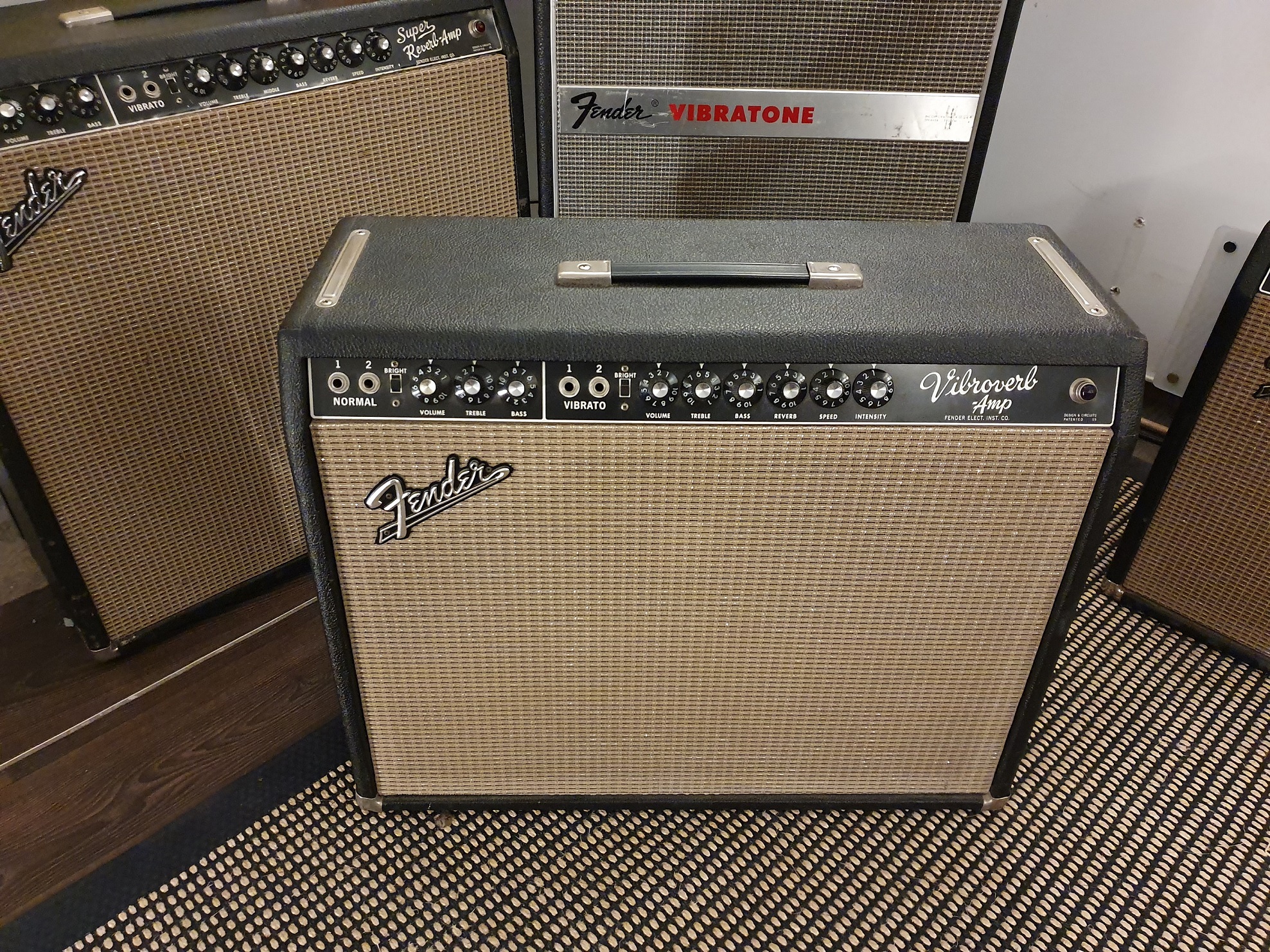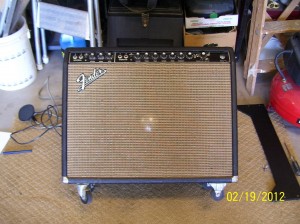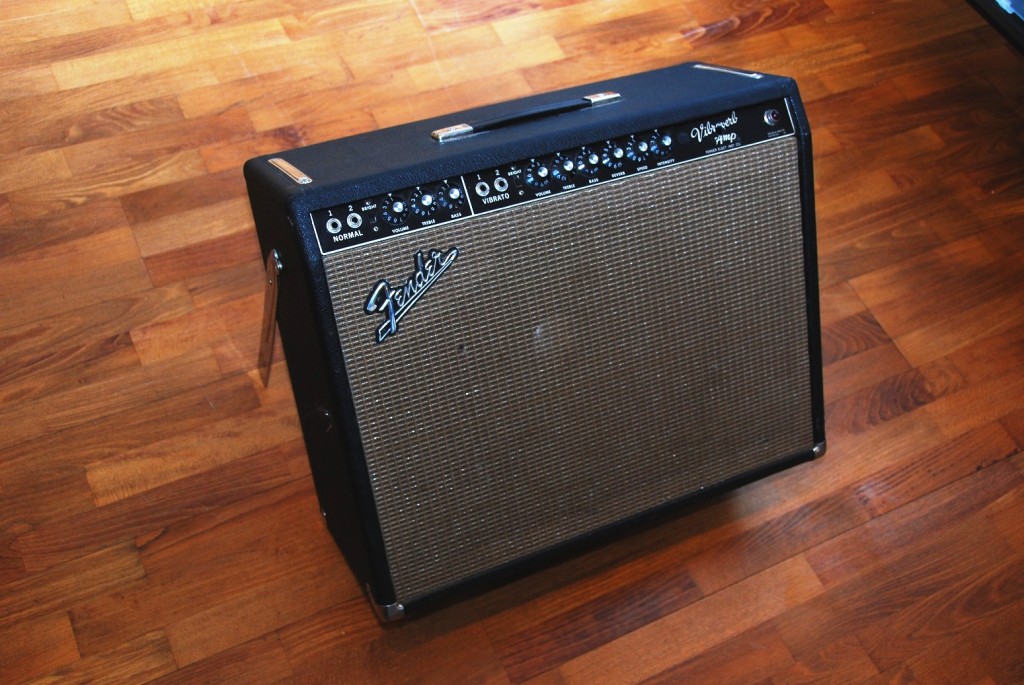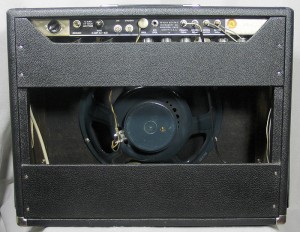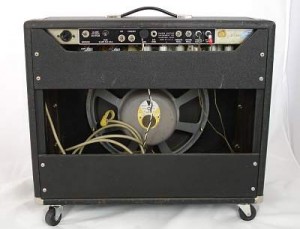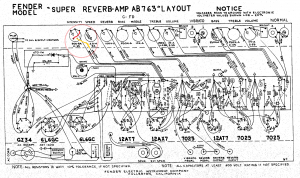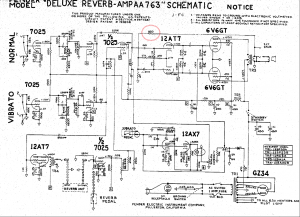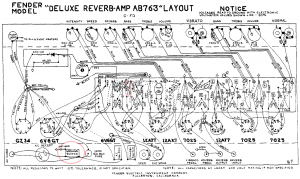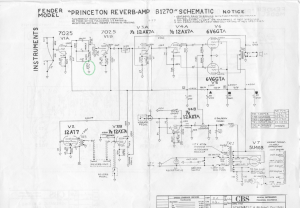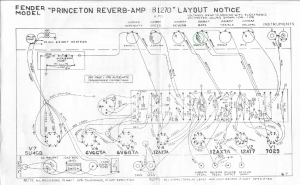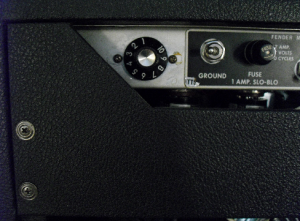Production years:
- 1964 blackface circuits AA763, AB763
Tube layout
AA763/AB763 Tube layout (Seen from behind, V1 is to the right side)
- V1 12ax7 = Preamp normal channel
- V2 12ax7 = Preamp vibrato channel
- V3 12at7 = Reverb send
- V4 12ax7 = 1/2 Reverb recovery and 1/2 gain stage for vibrato channel
- V5 12ax7 = Vibrato
- V6 12at7 = Phase inverter
- V7 6L6 = Power tube #1
- V8 6L6 = Power tube #2
- V9 GZ34 = Rectifier tube
Summary
Stevie Ray Vaughan’s musical influence has really hyped the blackface Fender Vibroverb. Because of him the Vibroverb has become the most expensive and sought after blackface amp on the vintage amp market. Though the Vibroverb is closely associated with SRV you can reproduce his tone with most Fender amps given the right speakers. See our SRV page for more information about Stevie’s tone.
Since Fender did not continue the Vibroverb after the CBS takeover in 1965, most likely because players didn’t desire 1×15″ amps at that time, there are only a few blackface Vibroverb amps out there. Given the hype and popularity, these few Vibroverbs are extremely valuable and collectable.
So, what is so special with the Vibroverb? First, the 15″ speaker sets it apart from most guitar amps. While most guitar amps have multiple 10″ and 12″ speakers the Vibroverb came with a big Jensen C15n or a JBLd130f, the last one with a huge magnet, aluminium dust cap and flat speaker cone that can be hard to tame in terms of treble, punch and attack. Beside the speaker the blackface Vibroverb is very similar to the other blackface and silverface AB763 Fender amps. In fact, there aren’t any different features or technical improvements in the Vibroverb that justifies its popularity. It’s all about emotions.
The Vibroverb belongs to the 6L6 Fender family. It is powerful and loud, but in a different way than the 10″ and 12″-amps. The Vibroverb did not sell very well in 64 and 65. Players probably thought the amp was suited for bass amps, we’re not sure. The Vibroverb did score among steel guitar players at the time. The 15″ speakers are firm in the bass and have lots of sparkle but most importantly, they have an enormous spread carrying the lower mids to anyone on stage. Mid frequencies is exactly what you need on stage in an electrical band. The mids will blend in nicely with the bass, drums, piano and horns. It will not interfere with the bass like a 4×10″ setup does. Of course this is a matter of taste, but a guitar tone with strong mids will contribute to a rich overall melodic footprint in an electrical band.
Many of the mods described below will make your amp break up earlier and reach the sweet spot at a lower volume. Tube mods (pulling V1 out and a 12ax7 PI) will take you a long way. If you also invest in implementing the tremolo disconnect mod, you can really make the Vibroverb break up at practise volumes. If you want to increase the clean headroom and do all the tricks Cesar Diaz did, Stevie Ray Vaughan’s guitar tech, we will try to explain all of this. We are not saying you will be happy with the tone or be able to play anything like Stevie, but there are a couple of key learning points in doing what Cesar Diaz did.
You’ll need schematics to implement some of these mods. http://www.ampwares.com/fender.asp. We usually start with explaining a mod from a functional perspective where we relate to components in the logical schematics diagram. Finally we point out location of components in the physical layout diagram.
The Texas Flood experience.
Let us talk about one of our most precious collector amps; the “Texas Flood Vibroverb amp”. One day in February 2012 we were contacted by a nice gentleman from Colorado, US, who was looking for a buyer for his 64 Vibroverb. He had to sell for personal reasons, involving buying a car (proving how collectable these amps are). His Vibroverb was a two-owner amp in very nice physical condition that hadn’t been played since 1987. It had the original transformers with 1963 date codes, original cover, footswitch and the two-prong power cord. The tolex, chassis and cabinet had been nicely treated but unfortunately the amp had a couple of nasty mods implemented by the first owner, such as a PPI master volume (post phase inverter), mid control and a non-original speaker, an Altec Lansing 15″ from the 60s. Otherwise the circuit looked original and had original components. This had obviously been a player’s amp and we have to believe in humanity that the first owner wouldn’t have implemented these mods to such an amp if he knew how much pain he would cost us all, including all of you who read this.
We inspected the high quality pictures that were sent us pr email. The two holes that were drilled in the faceplate for the master volume and mid control pots, penetrating the Vibroverb logo, held us awake for the next nights, but the Altec Lansing speaker excited us a lot. The Vibroverb that Stevie Ray Vaughan used to record his Texas Flood album in 1983 had an Altec Lansing speaker, which practically is an early JBL speaker made by James B. Lansing’s first company before he started the famously known JBL.(http://en.wikipedia.org/wiki/James_Bullough_Lansing)
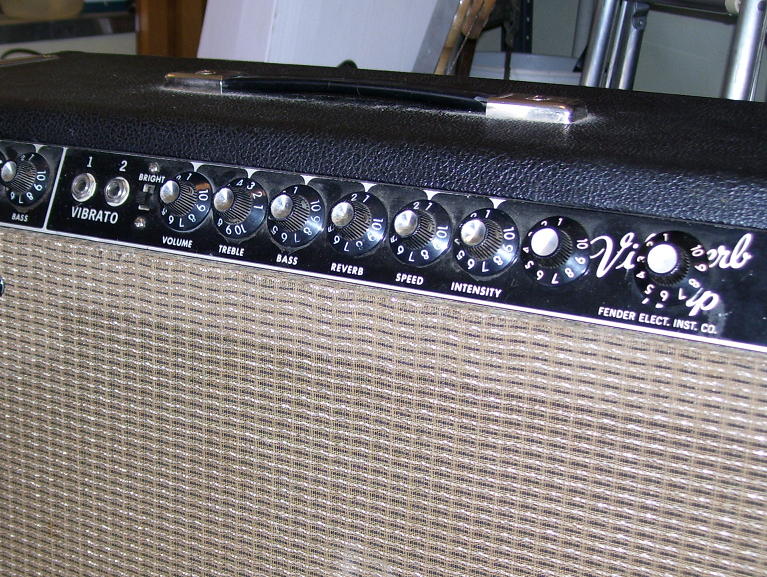
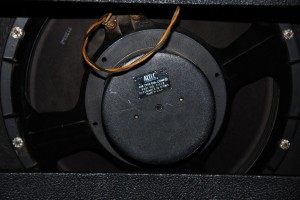
We now had an opportunity to obtain a Texas Flood Vibroverb delivering the legendary sweet tones of songs like Lenny and Texas Flood, music that made us want to become guitar players in the first place. These liquid, rich and clean “Fender” tones (all right, he used a Dumble as well) have motivated generations of players not to mention what it has meant for the popularity of the Stratocaster and Fender amps.
We were quite comfortable with all the circuit modifications. They could be reversed and we had seen them all before, mostly on silverface amps. The good physical condition of this Vibroverb(cabinet, tolex, baffle and chassis) was most important to us. The almost perfect tolex and grill cloth proved that amp hadn’t seen many ugly gigs and tours. The wood seemed robust in the cabinet and baffle construction. The penetrated faceplate was the main drawback. Finally, we decided to buy the amp for our collection and we managed to agree on a fair price with the seller, who was cooperating willingly and answered all questions we had. We completed the transaction with PayPal and after a long week a big 30 kg package arrived at our door.
We couldn’t remember being so excited in a long time as we unpacked the amp from its box. We removed all cardboards and found the amp bubble wrapped in many layers. The tubes, footswitch and power cable were separated and put safely in small boxes that were taped and isolated not to hurt the amp during transportation. The majestic amp was standing there beautifully in our garden and the ice cold winds from the Oslo fjord were not bothering us at all this Saturday morning. The sunshine from the amp kept us warm, but we knew we had a long path ahead of us. After opening the amp chassis and inspecting the circuitry closely, we made a todo list of everything needed to be done. The list contained twice as many activities than we initially planned for.
The ToDo list
- Repair and glue all loose speaker screws to the baffle, requiring removal of grill cloth.
- Baffle board screws were tightened.
- Replace the blue pilot light jewel with a correct red one from a silverface Super Reverb. The Super Reverb got a new red one and the blue was trashed.
- Replace the awful grey plastic speaker cable with a vintage correct yellow/black cable.
- Remove the four casters. Vintage correct chrome foots from the Super Reverb were installed.
- The cracked plastic handle was replaced by a nice one from the same Super Reverb. The Super Reverb got a new one.
- Remove the mid control and PPI master volume pots from faceplate. The 10K mid control pot was placed in the position of the Bass pot, which was shifted one position right along with all the other pots, reverb and vibrato. We soldered in a 6.8Kohm “mid resistor” on the bass pot according to original circuit design. The 6.8Kohm is a perfect value for the mid resistor, in our humble opinion. We couldn’t agree more with Leo in this design choice.
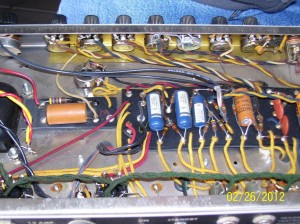
- Move bias cap fiber plate to original location. It had been moved to the center of the amp to make space for the master volume pot.
- Repair holes in the faceplate. One hole was covered with black tape, and the other was carefully painted with a black marker pen to minimize the injury. We haven’t decided yet if we will keep the original or get a new faceplate. A new plate would of course need to be reliced to look real and authentic.
- The bright cap consisted of two 120pF caps wired in parallel, meaning a 240pF value. The enormous treble spike was tamed dramatically by using just one 120pF cap as pr original design. Yet another good circuit design from Leo.
- The original power transformer was replaced by a 230V version from Mercury Magnetics (we live in Norway). After emailing Paul Patronete at Mercury Magnetics a package was on its way the next day.
- A new grounded three-prong power cord was installed, 5 meters long. We hate to have to ask anybody for a patch cable when rigging up our amp on stages.
- Bias cap and filter caps were replaced with new Sprague electrolytic caps to remove any potential hum and noise problems. We also like having fully charged batteries for maximum DC plate voltage.The purpose of the filter caps is to provide a constant DC voltage to all tubes. We kept the dual Mallory cathode caps as they seem to perform well. There was lots of punch and power in this amp.
- All pots were scratchy and noisy, which we had to expect from an amp not being played for 20 years. We rotated each pot 40-50 times and did not need a cleaner spray to remove static noise. We can live with a little noise as long as the signal remains strong and don’t get lost while turning the knobs.
- New 6L6GC power tubes from TAD biased at 35mA together with a new 5U4GB TAD rectifier. We did not install a GZ34 because we wanted the sag, sweetness and less clean headroom that the 5U4GB provides. The old RCA power tubes were not in good shape and sounded weak, and the original RCA rectifier tube provided a too low bias current. V2 preamp tube was replaced by a 7025 high grade TAD tube, a new TAD 12AX7 for the V4 reverb recovery and a new TAD 12AX7 for the V6 phase inverter. For the same reason as the rectifier tube we didn’t install a 12AT7 phase inverter. We left the V1 open for more preamp gain and kept the V3 reverb driver V5 tremolo tubes since they don’t matter anything for the tone as long as they work.
It took us approx 4 hours to complete the todo-list and the result was a much more vintage correct pre-CBS 1964 Fender Elect. Instr. Co. Vibroverb.
The tone
Having some experience with the JBL d130f speakers commonly found in Vibroverbs we had expected something close to that. Before playing the amp we wanted to establish a baseline tone in the room. You must always analyze, describe and compare tone with something else. We played a blackface 1966 Deluxe Reverb with Oxford 12L6 and a 1965 Super Reverb with CTS Ceramic. In terms of clean headroom the Vibroverb was somewhere in between these two amps, just as expected with a 5U4GB rectifier and 12AX7 phase inverter. The 15″ speaker had it all, lots of sparkle and punch. It felt much sweeter than the Eminence special design speaker to be found in the modern ’64 Vibroverb from Fender custom shop, where we earlier have experimented with lots of 15″ speakers. The Altec Lansing speaker reminded us tonewise of the Eminence Legend 1518, just not as loud and efficient. The tone spread was enormous and you can hear the amp anywhere in the room. It will cut through with any drummer and bass player. What we liked about the Altec Lansing speaker was that, despite the aluminum dust cover, it was not as ice picky as the JBL d130f speakers we had played earlier. This Vibroverb could be played with the bright switch on using single coil guitars. With our shell pink strat, (one piece nitro-painted Ash body, one piece maple neck, SS6105 frets and Lindy Fralin’s Hot vintage pickups) we found an excellent sweet spot at volume 4, bright switch on, treble 3, bass 4 and reverb 3. The tones of Lenny and Riviera Paradise came to us from above as we played directly into the amp. We continued with Texas Flood, the solo part and the characteristic turnaround licks until there was no more strength left in our left hand. It it truly amazing that Stevie could do such powerful bends and shakes with 013 on high E. Not moralizing too long about our own limitations we started to think – How about setting up an El Mocambo rig with our Super Reverb and Vibroverb combined? Perhaps throw in a front-side Analogman Tubescreamer TS9 for the rawer tones of So Excited and Pride and Joy.
The video below demonstrates a Vibroverb and Super Reverb together, Stevie’s El Mocambo rig.
The Fender Vibroverb shootout below demonstrates three different 15″ speakers:
– Inbuilt JBL d130f
– Emincence Legend 1518 in the big semi-closed 15″ extension cabinet in the back
– Jensen C15n in the Vibrosonic cabinet to the left
Five fundamental tricks to create the holy grail of Fender tone
Here is a video demonstrating the effects of some of the mods and tricks described here. To see embedded text comments, go to video on Youtube.
Speaker
The Vibroverb came originally with either JBL d130f, CTS or Jensen C15n speakers. The JBL d130f is one very popular vintage speaker. With its aluminum dust cap it was known for a treble spike and there are various opinions about the tone of this speaker. Having tried it ourselves, we prefer a paper dust cap in stead of aluminum to smoothen the tone, also allowing the use of the bright switch. The Jensen C15n represents a more typical vintage Fender tone, but it could not handle as much power as the JBL and blew from time to time. The output transformer’s lack of ability to deliver a firm bass tone at higher volumes, like the larger iron in the twin reverb, challenges the speaker even further with a loose and boomy bass tone.
Replacing the speakers in your Fender amp is the easiest and most effectful mod you possibly can do. Tonewise, the speaker is the most important component in your amp. I a 1×15″ application we prefer a full tone speaker with big low end and sparkling highs. The 15″ speaker produces lots of low/mid frequencies due to its physical dimension and will cut through any drummer and bass player. It does not push as much air with low ends like 4×10″ and 2×12″ configurations, but who cares. The guitar tones on a stage are all about mids. The weight of one 15″ speaker is usually not a problem so we’re not afraid of installing a heavy speaker in this amp.
See page How to select speakers for general speaker recommendations.
12AY7 or 12AT7 as preamp tubes – Less preamp gain.
If you want cleaner and spankier preamp distortion characteristics, you may replace the V1 or V2 12AX7 preamp tube with 12AT7 and 12AY7. These tubes have different frequency responses than 12AX7, particularly when distorting. People describe these tubes to have less harsh and buzzy distortion. This mod does not alter the tone significantly when amp is played clean or when only the power amp section distorts. You’ll have to increase the volume setting to achieve a similar volume as before. The reason is that 12AX7 tube has a voltage gain factor = 100, while 12AT7 = 60 and 12AY7 = 45.
Pull out the V1 normal channel preamp tube – More preamp gain in vibrato channel
We’ll start with saying that this is a mod we personally do to all dual channel blackface, silverface and reissue amps. It is so easy to enable and disable that it can hardly be called a mod. If you are like most players and only use the Vibrato channel (reverb, tremolo, the bright cap and the extra gain stage), you should pull out the V1 tube. This is the preamp tube for the normal channel which you are not using when playing the Vibrato channel. Vice versa; If you’re using the Normal channel, you can pull out the V2 tube. All AB763-similar circuits (Deluxe Reverb, Super Reverb, Pro Reverb, Twin Reverb, Vibroverb, Vibrolux) are designed so that they share the cathode cap and resistor (25 uF/1500 ohm) and pulling one of the tubes will changes the effective value of the resistor they both share. If you pull one tube the other channel’s tube will be hotter biased and offers more gain. The amp will play louder than before given the same volume knob setting. The stronger signal will push the second gain stage (V4 tube) harder and give you increased sustain, compression and harmonics. This mod does not change the amp’s clean headroom but increases the preamp gain and preamp distortion.
This mod is one of Cesar Diaz’ tricks in the Fender Custom Shop Vibroverb 64 which he always did to Stevie’s amps. This mod is safe. It has stood the test of time and been been done by players in 50 years in blackface Fender amps.
Replace the 12AT7 PI tube with a 12AX7 or 12AU7 – Less clean headroom.
Very practical mod at practice and low volume environments. This mod reduces the amp’s clean headroom and you’ll achieve sweet spot at a lower volume. You’ll notice that the amp gets looser and with less attack. Tips: If you pulled the V1 12AX7 tube you may use it as V6 phase inverter.
12AX7 as phase inverter tube will give the most effect out of this mod. 12AU7 will be in between 12AT7 and 12AU7.
Replace the 12AT7 reverb driver with 12AU7 – Better reverb control.
Reverb is an important character with vintage amps, yet so individual and mysterious. We all know that speakers change their tonal character during age. So does the reverb. The reverb function sounds and behaves differently between “identical” vintage amps. Some amps have long, lush and soft reverb while others are mushy and overwhelming. We often find the reverb sweet spot around 2.5 on the reverb pot, varying from 2 to 4. Some amps are sensitive and difficult to control the reverb on. The whole dynamic area can be within a narrow interval, i.e. 2 and 2.5. These amps require a careful touch when dialling in the reverb, which irritates us.
The reverb circuitry consists of two tube sections (reverb driver V3 and reverb recovery V4) and the physical reverb tank. All these components will drift during age and minor differences in component values are noticeable to man’s ear.
If you replace the V3 12AT7 reverb driver with a 12AU7, you will reduce the effect of the reverb and it will be much easier to control with the reverb knob. So simple as that.
Use normal channel for reverb control – Adjust EQ and depth of reverb.
This mod is relevant only for two-channel amps with normal and vibrato channel. This trick is great for the reverb enthusiasts among us, and who is not? Plug your guitar into the vibrato channel, then unplug the reverb return cable on the back of the amp (the one that comes from the reverb tank output) and plug it into the normal channel input. You will need a converter to go from male phono/RCA jack to a 1/4″ male jack. You may now use the normal channel as a reverb control where you can adjust the depth and tone using the volume, bright switch, treble and bass knobs (and mid if you have a Twin Reverb). The reverb knob on the vibrato channel will have no effect any longer.
This mod is not applicable together with the Pull V1 mod, as you need the normal channel preamp tube.
Diode rectifier – More clean headroom.
This is one of Cesar Diaz’ regular mods to Stevie Ray Vaughan’s amps, which is implemented in the newer Fender Custom Shop 64 Vibroverb. This mod is for those who need more power, clean headroom and attack. It is very practical to carry with you those small Sovtek plastic adapters that quickly and easily replaces the rectifier tube. You’ll increase the power of the amp with a few watts. The diode rectifier will feed your amp’s filter caps with a higher and “faster” DC voltage compared to a tube rectifier. The fact that it delivers a slightly higher DC voltage to your power tubes (via the filter caps) means an increase of the tube voltage gain factor. When you hit a hard chord the preamp and power tubes will require energy and current is flowing from the DC filter caps which are charged up by the rectifier. If the rectifier can deliver more energy more quickly, you’ll have more power and attack.
Check also out Ted Weber’s “Copper Cap Rectifiers” that emulates the sag of a tube rectifier.
Tremolo disconnect mod – More preamp gain in vibrato channel.
Also one of Cesar Diaz’ regular mods to Stevie Ray Vaughan’s amps, which is implemented in the newer Fender Custom Shop 64 Vibroverb. The effect of this mod is similar to pulling the V1 normal channel preamp tube when playing the vibrato channel. This is also a very popular mod in AB763-similar circuits (Super, Twin, Vibroverb, Pro Reverb, Deluxe, Vibrolux).
By original design the tremolo circuit will absorb current/signal even when one turns the tremolo off with the footswitch. This mod suggests to entirely disconnect the tremolo circuit from the signal path by replacing the tremolo intensity pot with a switchable pot (spst). One side effect with this mod is a noticeable click and a volume difference between tremolo on and off using the new spst pot. If one uses the tremolo regularly one should still use the tremolo pedal to enable/disable the tremolo and leave the intensity spst pot at your desired level. The spst pot is not good for enabling and disabling the tremolo very often (because of the click and the volume difference) but is a nice when you play without tremolo. A good thing with this mod is that you have both the tremolo pedal and spst pot to use.
With a new switchable/spst pot set at intensity=0 the mod will kick in and raise the signal level in the preamp section, right before the phase inverter. Once you’re turning up the tremolo the circuit is connected again and the tone will remain original. This mod does not increase the amp’s clean headroom. We would describe the effect as making the tone richer, fuller and more powerful with stronger mids that pushes the power amp section harder (phase inverter + power tubes). We like this mod a lot for stratocasters wi the Fender AB763-similar circuits since they boost a relatively scooped and thin sounding guitar and amp. In addition to pulling the V1 tube, this mod is one of those must have mods which we never undo once having implemented it.
This mod is one of Cesar Diaz’ tricks in the Fender Custom Shop Vibroverb 64 which he always did to Stevie’s amps. This mod can be implemented in two ways, either by unsoldering the tremolo circuit or replacing the tremolo intensity pot with a switchable pot, so-called SPST pot. The switch is enabled when you turn down intensity to zero. There are also switchable push/pull pots where you pull the knob to enable the switch.
- Order a 50k SPST from one of our recommended amp part dealers.
- Remove the original 50k trem intensity potmeter by unsoldering the wires to the potmeter lugs and unount the pot from the chassis. The black plastic wheel is to be used for the new pot.
- Install the new 50k SPST pot to the chassis. This is a switchable pot offering a mid positioned switch in addition to the variable resistance 0-50 KOhm between the lugs. At level=0 you’ll completely disconnect the tremolo circuit.
- See the wiring diagram below.
- You’ll have to solder the yellow wire to one side of the mid positioned switch instead of to the right pot lug as before.
- Then solder a new (red) wire between the other side of switch to the right lug.
If you’re permanently disconnecting the tremolo circuit you can just clip of the brown and yellow wires and insulate the ends with tape. Note that the figure below shows the Super Reverb. The Vibroverb would be the same.
(One may also use the tremolo pedal, instead of the spst switch/pot, to entirely disconnect the tremolo. You will not need to replace the intensity pot with a spst, but let the yellow wire to the tremolo pot go through the tremolo pedal. In our opinion this is not a good idea since one loses the possibility to use both the spst switch and tremolo pedal. Using the pedal will now involve a significant click sound and volume increase.)
Twin Reverb output transformer – More power, more attack.
Cesar Diaz mods to SRV’s Vibroverbs sometimes included a bigger output transformer to minimize sag and compression and maximize clean headroom and attack. Personally we do not enjoy this mod in big Fender amps, unless we want a SRV demo amp, because we like a certain amount of sag. The attack and treble tones in the bigger Fender amps are mean and clean enough. The increased weight with bigger iron transformers is also a burden. In smaller amps, such as the Deluxe Reverb and Princeton, we find it useful with bigger output transformers to get a little more out of them.
Negative feedback loop
The negative feedback loop can easily be tweaked to alter the treble cut and distortion in your amp. The purpose of the NBF loop is to clean up the tone and cancel out the mid/higher frequencies and upper harmonics (distortion) at the entry point of the phase inverter which is placed in front of the power tubes. The NBF theory is that you take the signal from the speaker output, let it go through a resistor and mix it in at the entry point of the phase inverter. The speaker signal is out of phase (180 degrees) with the signal at the entry point of the phase inverter and will cancel out equal frequencies. If you disconnect the NBF loop you’ll notice that the volume increases and tone gets much more aggressive. More white noise too. unfortunately, which is why there is a NFB loop. You will fin the amp’s sweet spot at a lower volume knob setting without the NFB loop. Not only is there a volume shift, the amp’s clean headroom is reduced slightly. Most importantly the tone gets rougher and rawer with more mids and higher frequencies, aka presence. If you think your tone is too bright or harsh or you’re seeking a mellow and nice clean tone, you probably want to keep the NBF loop. This mod is for those who want more bite and a tone that really cuts through in the mix.
You may choose to implement the mod in several ways and in various combinations with the ground switch or a foot pedal. A foot pedal works like a boost/FAT pedal. If yo’re struggling to find a transparent boost pedal that keeps the natural Fender tone you should try this out. You will still have that beautiful Fender tone, just more and wilder.
- No negative feedback at all. Simply disconnect the feedback loop (a wire) and tape insulate it. You get the most effect of this mod by disconnecting the NFB loop entirely. You may experience that the tone gets harsh, depending on guitar, speakers and EQ settings of course. If so, read more about the cap in the next bullet point.
- Keep the feedback loop and install a .01 µF in series with the NBF resistor. This cap will prevent the lower and mid frequencies to go through the NFB loop. Depending on the cap value treble frequencies will be fed back to the phase inverter which cancels out the treble in the main path. The tone gets less harsh and you still have a noticeable effect. You should experiment with different cap values. Start with 0.01µF.
- Increase the feedback loop resistance value. A good starting point is twice the original resistor value. This reduces the effect of the feedback loop, making the amp break up more when the NFB is engaged. If you make the NBF switchable there will be less volume difference if you use a high resistor value. (Using a .01 µF cap is also recommended to minimize the difference a little bit between NBF on and off).
- Use the ground switch or foot pedal to make the NBF switchable. If you remove the death cap and free up the ground switch by removing existing wires to it (if you’re wondering what the ground switch does, you don’t need it). Then wire the ground switch in series with the NBF resistor. If you’re using a cap in the NBF loop this goes across the switch allowing treble to bypass independent of the switch. When the ground switch has disconnected the NBF loop the higher frequencies are still fed back through the cap. In practice you solder each the two cap legs to at each side of the switch between speaker terminal and NFB resistor.
Where to install foot-pedal or switch? The ground switch is easy available if you disable the power supply wires and death cap. For amps with reverb you could use the reverb footswitch phono plug if you are not using it.
Logical schematics
Layout
Click images for full size versions.
Middle pot
The Vibroverb did unfortunately come without a mid pot. Many players are happy with the default 6.8K mid resistor in the EQ circuitry, but some want what the others have; a 10K potmeter mounted in series with the 6.8 Kohm resistor. When the potmeter is set at 0 you’ll have an original tone, and when turned up the mids increases and your amp growls with a British Vox’ish tone (especially together with a Celestion speaker). For a wider tone range you can replace the 6.8 KOhm resistor with a 4 KOhm, and use the 10 K pot to go beyond the original 6.8 KOhm and up to 14 KOhm. If you do not use the reverb or tremolo pedal it is very practical to install the middle pot here. It requires a simple solder and removal job to replace the phono plugs with a mid pot. Or you could install the mid pot at the left most side of back of the amp where the additional power supply is located.
Logical schematics (Princeton Reverb is shown, but Vibroverb is the same in this context)
Layout
